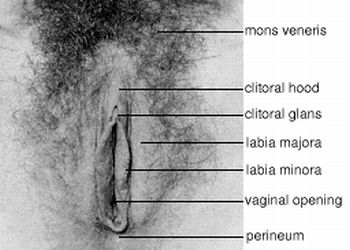Labia
- This is an article about Human Anatomy
Labia Majora
The labia majora (singular: labium majus) are two prominent longitudinal cutaneous folds which extend downward and backward from the mons pubis to the perineum and form the lateral boundaries of the cleft of venus, which contains the labia minora, interlabial sulci, clitoral hood, clitoral glans, frenulum clitoridis, the Hart's Line, and the vulval vestibule, which contains the external openings of the urethra and the vagina.
Each labium majus has two surfaces, an outer, pigmented and covered with strong, crisp hairs; and an inner, smooth and beset with large sebaceous follicles.
Between the two there is a considerable quantity of areolar tissue, fat, and a tissue resembling the dartos tunic of the scrotum, besides vessels, nerves, and glands.
The Labia Majora are thicker in front, where they form by their meeting the anterior commisure of the labia majora.
Posteriorly they are not really joined, but appear to become lost in the neighboring integument, ending close to, and nearly parallel with, each other.
Together with the connecting skin between them, they form the posterior commisure of the labia majora or posterior boundary of the pudendum.
The interval between the posterior commissure of the labia majora and the anus, from 2.5 to 3 cm. in length, constitutes the perineum.
The labia majora correspond to the scrotum in the male.
Between the labia majora and the inner thighs are the Labiocrural Folds.
Between the labia majora and labia minora are the interlabial sulci.
Labia Minora
The labia minora (singular: labium minus) are two small longitudinal cutaneous folds, situated between the labia majora, and extending from the clitoris obliquely downward, lateralward, and backward for about 4 cm. on either side of the vulval vestibule, between which and the labia majora they end; in the virgin the posterior ends of the labia minora are usually joined across the middle line by a fold of skin, named the frenulum labiorum pudendi or fourchette.
Anteriorly, each labium minus (nympha) divides into two portions: the upper division passes above the clitoris to meet its fellow of the opposite side, although not necessarily its equal in size, forming a fold which overhangs the glans clitoridis, and is named the preputium clitoridis; the lower division passes beneath the glans clitoridis and becomes united to its under surface, forming, with its fellow of the opposite side, although not necessarily its equal in size, the frenulum clitoridis.
On the opposed surfaces of the labia minora are numerous sebaceous follicles.
What links here • References and Sources • Contact info
